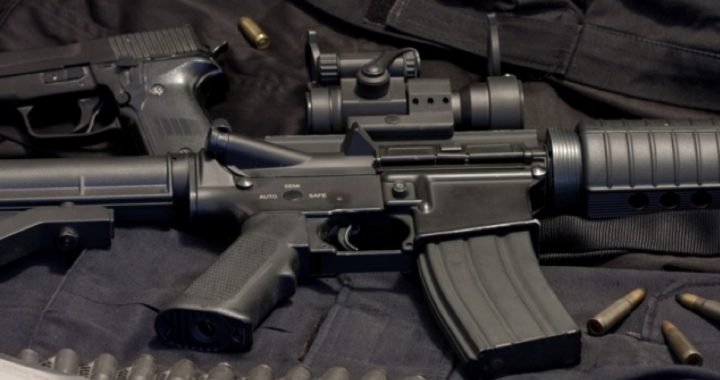
Connecticut has some of the most strict gun control laws in the nation, passed in the aftermath of the Sandy Hook Elementary School shooting. Highlights of the law include a prohibition on the sales of firearm magazines that hold more than 10 rounds of ammunition, a ban on many guns deemed by cosmetic looks to be “assault weapons,” mental and criminal background checks to buy a gun, certificates for gun and ammunition sales, and a firearm registry for certain types of guns.
Now that the law is in effect and many Connecticut gun owners either refused to register their guns or registered after the deadline, meaning they are guilty of a felony, conflicts between people made felons overnight by government legislation and the police are inevitable. Rich Burgess, president of the pro-gun group Connecticut Carry, sent a memo on Monday to his membership, saying that Connecticut state officials “now look down the barrel of the laws that they created, and it is very probable that they now tremble as they rethink the extremity of their folly. Connecticut Carry calls on every official, every Senator, and every Representative, to make the singular decision: either enforce the law as they are written and let us fight it out in court, or else repeal the 2013 Gun Ban in its entirety.”
The issue is in fact being fought out in court, and the first round went to the state. While the status of those who have received back their applications for registration of their “assault” weapons and magazines because they missed the December 31 deadline is still in limbo, senators and representatives are no doubt resting easy, for the moment.
Calls for insurrection and lethal opposition when police come to the door, such as that made by Mike Vanderboegh, are not being acted upon.
On January 30 U.S. District Judge Alfred V. Covello returned his verdict in favor of Connecticut’s new gun laws. It was immediately appealed by the plaintiffs, which include June Shew, the Connecticut Citizens’ Defense League, and the Coalition of Connecticut Sportsmen. The defendants include Connecticut’s Governor Dannel Malloy, Kevin Lawlor, and others working to implement the law.
In Shew v. Malloy, the judge was asked to rule on three complaints: 1) that the new law violated the plaintiffs’ right under the Second Amendment to keep and bear arms; 2) that the law violated the Equal Protection Clause of the 14th Amendment; and 3) that the law was unconstitutionally vague in its descriptions of exactly what weapons were now outlawed, including the various features that suddenly turned them into “assault” weapons.
The judge tossed all three:
The court concludes that the legislation is constitutional. While the act burdens the plaintiffs’ Second Amendment rights, it is substantially related to the important governmental interest of public safety and crime control.
With respect to the equal protection clause … while the legislation does not treat all persons the same, it does not treat similarly situated person disparately.
Finally, while several provisions of the legislation are not written with the utmost clarity, they are not impermissibly vague … and therefore, the challenged portions of the legislation are not unconstitutionally vague.
Nothing in his 47-page opinion mentioned anything about the required registration of “assault” weapons and magazines with the state.
The judge noted that the ban was not a complete ban of all weapons with no exceptions:
For example, a person is exempt if they “lawfully possessed an assault weapon” before April 4, 2013, the effective date of the legislation, and “applied by January 1, 2014 to the Department of Emergency Services and Public Protection for a certificate of possession with respect to such assault weapon.
Besides, the police and other members of law enforcement are exempt from the law, so it wasn’t a complete ban:
In addition, LCMs [limited capacity magazines] may be possessed, purchased, or imported by “members or employees of the Department of Emergency Services and Public Protection, police departments, the Department of Correction, the Division of Criminal Justice, the Department of Motor Vehicles, the Department of Energy and Environmental Protection or the military or naval forces of this state or of the United States for use in the discharge of their official duties or when off duty.
However, with those exceptions, anyone else who is not exempted and possesses an assault weapon after December 31, 2013 “shall be guilty of a class D felony,” wrote the judge.
The judge spent most of his opinion determining whether such weapons were in common use across the country and so would, by inference, be subjected to illegal discrimination by Connecticut’s law. The response from the defendants was predictable: that this represented a “absolutist interpretation” of the Second Amendment. In other words, some weapons were intended to be exempted from coverage, and it was up to the judge to determine just which those were. He jumped through numerous intellectual hoops in order to support the state. For instance he wrote:
The U.S. Court of Appeals [in Heller II] thought “it clear enough in the record that semi-automatic rifles and magazines holding more than ten rounds are indeed in ‘common use.’”
However, the court could not “be certain whether these weapons are commonly used or are useful specifically for self-defense or hunting and therefore whether the prohibitions of certain semi-automatic rifles and magazines … meaningfully affect the right to keep and bear arms.”
That’s the opening through which the judge drove his ruling: that the weapons banned in Connecticut were really outside the mainstream and so therefore ought to be banned.
The judge didn’t take exception to the defendants’ argument that banning such weapons and magazines would substantially reduce crime in Connecticut. He also allowed the argument that a gun’s “cosmetic” features — pistol grips, barrel shrouds, and the like — also made them more dangerous: “The assault weapon features increase a firearm’s ‘lethalness’ and are therefore related to a compelling interest of crime control and public safety.”
The judge wrote that he had no idea whether or not the legislation would actually achieve its objective: the reduction of crime:
Obviously, the court cannot foretell how successful the legislation will be in preventing crime. Nevertheless, for the purposes of the court’s inquiry here, Connecticut, in passing the legislation, has drawn reasonable inferences from substantial evidence. As such, the legislation survives intermediate scrutiny and is not unconstitutional with respect to the Second Amendment.
When considering the claim by the plaintiffs that their rights under the 14th Amendment’s equal protection clause were being violated by the new law, the judge had to hold that the law applies equally to all, but to some more equally than others. In order for the violation to occur, plaintiffs would have to show that they had the same interests as police or other law-enforcement officials. Wrote the judge:
The equal protection clause does not forbid classifications … that “most laws differentiate in some fashion between classes of persons….”
[The Fourteenth Amendment] “simply keeps governmental decision makers from treating differently persons who are in all relevant respects alike.”
And because the plaintiffs, according to the judge, failed to meet the “requirement of demonstrating that they are similarly situated to the exempted personnel in the legislation,” their claim of violation is negated:
The court concludes that the plaintiffs have failed to prove the threshold requirement that the statute treats differently persons who are in all relevant aspects alike. Thus, these provisions do not violate the Equal Protection Clause of the Fourteenth Amendment.
The judge much more easily dispensed with the complaint that the offending legislation was vague, discussing pistol grips, the phrase “copies or duplicates” when referring to one-off copies of those specifically mentioned in the legislation as now being illegal, the term “assault weapon,” the phrase “modification, alteration, or assembly” that would require citizens to have a vast knowledge of gunsmithing in order to determine those weapons now deeded to be illegal, and the phrase “capacity to accept more than ten rounds.” After nearly 10 pages of opinion, the judge concluded: “The court concludes that this provision of the legislation … is not impermissibly vague in all its applications and, and such, it is not unconstitutionally vague.”
Attorney Brian Stapleton who represented the plaintiffs saw plenty of opportunity to file an appeal, which was filed the day after Covello’s decision was rendered:
This is a long way from [being] over. We respect Judge Covello, but respectfully disagree with him.
An appeal was anticipated in this case. There are findings [in his ruling] that we can work with and we are going to do everything we can to get this overturned.
In the meantime the situation in Connecticut will continue to be monitored as the senators and representatives who passed this law will have opportunities to reconsider their decision. Jumping the gun (so to speak) on enforcing the law before it has been carefully and more objectively reviewed by other judges and courts could lead to unknown and potentially disastrous consequences. The best thing those senators and representatives and law-enforcement officials could do would be to let this law simmer on the back burner and let the legal challenges finally resolve the issue.
A graduate of Cornell University and a former investment advisor, Bob is a regular contributor to The New American magazine and blogs frequently at www.LightFromTheRight.com, primarily on economics and politics. He can be reached at [email protected].



